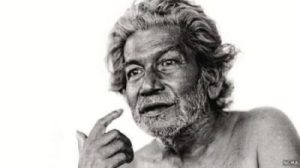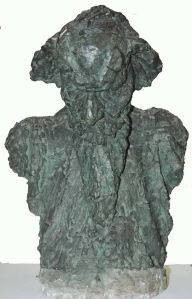Translated from the Bangla by Bhaswati Ghosh
First published in Parabaas

It must have been the middle of the 60s decade—or was it the beginning? I don’t remember the year, only that the days were of intense spring. The festival of colours had ended just a few days ago.
Shakti said to me, “Samir, let’s go to Santiniketan. The Khoai area is ablaze with Palash now.” Shakti had just crossed 30 and was neck deep in his Birbhum phase. Every year, his presence at the Kenduli baul fair was almost a given. He didn’t just have a personal relationship with the bauls who came to the fair, as Chandi Lahiri has written, he was intimately in touch with their family affairs, joys and tribulations. Nabanidas (Purnadas Baul’s father) was still alive at the time; after retiring from the post of peon in Sultanpur Sriram High School, he had built his akhra at the outskirts of Siuri town. Shakti would run to that place on a whim and return only after spending a few days there. He was dear to Nabanidas. Shakti was not acquainted with Meenakshi yet. He said to me, “Let’s go—I haven’t met Kinkarda in a while. We will spend a night with him; then go to Siuri.”
In those days, it used to take a long time to reach Santiniketan. There weren’t too many good trains, land prices in Santiniketan hadn’t started shooting up as yet, the rich of Kolkata hadn’t begun occupying Khoai to build houses.
By the time we reached the place, the afternoon had nearly slipped away. Just before Cinematola, there used to be a country liquor shop called Akorshoni; Shakti stopped the rickshaw there and grabbed a couple of bottles.
Next, he stopped the rickshaw in front of Ramkinkar’s house and said, “Wait; we won’t let go of the rickshaw yet. Let’s check if Kinkarda is there or not.” He used to go away to Jugipara at times. Acting like a detective, I said, “The door is ajar; he must be there…” Shakti looked at me and said with a smile, “Kinkarda never locks the door.”
“What? He goes away to his village without locking his door?”
“He doesn’t have any lock; Kinkarda, O Kinkarda…” Shakti started yelling from the rickshaw itself. A barefoot Kinkarda came out, tending to his lungi. “Arre, poet, you are here—come, come, I hope you have got something for me? Who’s that with you?”
As he picked up the jute bag from the rickshaw base, Shakti laughed and said, “I have brought stuff, Kinkarda. This is my friend, Samir.”
“Does he write poetry?”
I quickly folded my hands and said, “No, Kinkarda, I don’t write any poetry.”
Kinkarda rolled his eyes and said, “Then why have you come here?”
My hands still folded, I said, “To give company to Shakti and to see you.”
He just said, “Oh” and then completely oblivious to my presence, took Shakti inside the room, almost in a warm embrace. I guess he remembered me while crossing the door; he looked back and said briefly, “Come.”
I entered the house. The famous house that has been described by so many. The signs of poverty were everywhere. On one side was a string cot with dull, faded bedding. On top of the bedposts lay a folded, dirty, almost blackened mosquito net. A few painted canvases lay above the net. We learned that it had rained a few nights ago and water was leaking through a hole on the roof. An irritated Ramkinkar had woken up; put a few canvases atop the mosquito net and gone back to sleep. If water had to drip, it would fall on the canvases.
Ramkinkar squatted on the floor; we followed suit. Butt-ends of bidis were strewn everywhere. Kinkarda pulled out a few earthen tumblers from beneath the cot. As he used his seasoned hands to remove the tar-sealed cap, he called out, “Mungri, O Mungri…” A good-looking adivasi girl came and stood at the rear door. Ramkinkar uttered some instructions to her in a language unknown to us; the girl disappeared. He looked at Shakti and said, “I sent her to her village to check if she could fetch us some grilled pork.”
It was almost three in the afternoon. He never asked if we had any lunch or not; food arrangements meant that pork meat, if available. He poured the liquor into the tumblers with great care and presented them to us in a manner befitting a Japanese tea ceremony host.
The pork came and vanished; a rickshaw-puller was made to bring two more bottles, along with some roasted chickpeas; those were gobbled up in no time. Two more were brought by paying a premium—it was past ten in the night. I don’t remember anything after that. I just remember endless country liquor, endless bidi smoke, endless talk, endless songs of Tagore, sung in broken voices.
I don’t know what time of the night it was when my consciousness returned, triggered by severe thirst. The early summer heat of Santiniketan’s Chaitra, coupled with limitless tumblers of undiluted country liquor might have been nothing unusual for Kinkarda and Shakti. I was sheer lucky not to have suffered dehydration.
For a while, I kept sitting quietly. It was pitch dark and the place unfamiliar to me. I extended my hand and felt Shakti, sleeping unconsciously beside me. I couldn’t spot Kinkarda. But it seemed as if my life would ebb away without water—the body was so dry. Where could I find some water?
While still sitting I felt the darkness melting away a bit. How did that happen? Was dawn approaching? I turned back and figured a light in the shape of a small rectangular door—a lantern must have been lit somewhere inside. Could I find water there?
As I started getting up, extreme dizziness gripped me—it was impossible to stand. I sat down. The moment I moved a bit, the unknown world around me started swaying. But I had to drink some water. After a while, I gathered enough strength to crawl towards the door.
The door led to a verandah; on the left, with his back to the door, at approximately a thirty-degree angle sat Kinkarda on a stool, stark naked. He hadn’t noticed his lungi slip off his waist. Before him, on a high stool (I don’t remember if it was a turntable or not) stood an unfinished clay sculpture; the lantern was hung on a bamboo support fixed to the ceiling. His right hand held a small fistful of clay. Sitting on the stool, Ramkinkar stared at his work—motionless. A million mosquitoes were clouding around him, but he didn’t seem to notice. His eyes had a strange, blank expression—he looked on, but didn’t seem to see with his physical eyes. It was more of what Ramakrishna had called a yogi’s eyes—he had said that when a bird sits on her eggs, the look in her eyes suggests that she was looking, but not really seeing anything; all her focus remains concentrated on her eggs. Ramkinkar had the same look in his eyes.
Even in my semi-conscious state I realized I had trespassed. I had no business there; even if I died of thirst, this wasn’t a place to ask Ramkinkar for water. And even if I did, he wouldn’t be able to offer me any. I crawled back to the room and lay down with my parched throat.
It must not have been more than a minute. I saw Ramkinkar only that one time, nearly fifty years ago—yet it is one of the few visual memories that remain immortal in my petty life. After my death, if God asks me what I saw in the world of dust and clay, I will be able to say, “I saw your contender, immersed in his art of creation.”
Translated from Amar Bondhu Shakti (আমার বন্ধু শক্তি) by Samir Sengupta; published published by Parampara, Kolkata in 2011.











